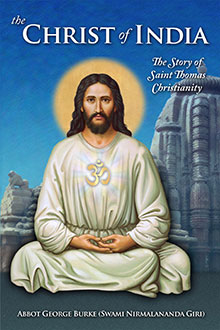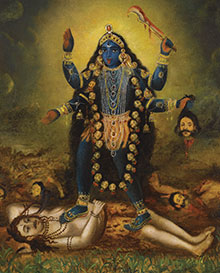 Q: I have read much of your site and The Christ of India and am interested in the dharmic approach taken by the Saint Thomas school–most of which seems natural to me.
Q: I have read much of your site and The Christ of India and am interested in the dharmic approach taken by the Saint Thomas school–most of which seems natural to me.
While there is documentation on Hindu acceptance and worship of Christ, how can a follower of Christ respectfully and meaningfully engage with Hindu aspects, from specific helpers such as Ganesha to omnipotent archetypes like Shiva?
I attend a Tamil Mariamman temple from time to time and experience no inconsistency but am still reserved in my engagement.
Any pointers will be much appreciated.
Sanatana Dharma did not come out of the mind and ideas of some individual who then persuaded others to follow him. Rather, it is a revelation given to many sages (rishis), who were master yogis, in their superconscious experience. That is why there is no founder claimed by Sanatana Dharma.
Also, that revelation can be confirmed by yogis who purify themselves and become able to enter the same superconscious state.
Sanatana Dharma is based on realization, not intellectual philosophy. Consequently, only the adept yogi can really understand its nature and meaning. Yoga Sadhana is the key to really “becoming” a Sanatana Dharma. I say this from experience. There were many aspects of Sanatana Dharma that upon first encounter seemed utterly silly to me. But as I persisted in meditation and yogic discipline I literally saw the reality and value of them.
I will share with you some experiences I had.
An elephant headed God
One day I went with some yogi friends to the now extinct Wil Wright’s Ice Cream Parlor in Westwood, California. In a niche to one side of the door there was a white marble statue with the head of an elephant. One of my friends pointed to it and said: “That is the Indian Elephant-headed God, Ganesha. I don’t know what it’s doing here.” Neither did I, for I was thinking: “Elephant-headed God! Whoever thought that up? How stupid.” But some weeks later in meditation I saw Ganesha and knew he really was a form of God. And more than that: I loved him. I not only believed in him, I got an image of him and put it on my meditation altar.
 Dark Kali and the storm
Dark Kali and the storm
I was completely disgusted with the idea of the Goddess Kali. I thought it was horrible. Then one night in meditation during a tremendous rain storm I saw the Devi dancing in the storm, stamping her feet with great vigor on the earth. And I understood. The next day I took an anti-Hindu book I had bought long before becoming a yogi, cut out the picture of Kali, threw the book in the garbage and kept the picture with me at all times. How I loved worshipping in the Kali temples when I went to India!
Cloud colored Krishna
I read that Krishna was blue. I figured that was symbolic, but when I saw Krishna, Shyam Sundara the Beautiful Dark One, he was blue. Not like the blue of many modern pictures and images, but a dark, dusky blue. Some months later I saw a dark storm cloud in the sky that was the exact color I had seen in my vision. And quite some time later I learned from a Gujarati friend that Krishna is sometimes called Ghanashyam–dark like a cloud.
Green Rama
Later on I read that Rama was green. In the perspective of the foregoing experiences I was not so quick to reject it, but then I remembered that the skin of Europeans and Americans actually contain green pigment. So perhaps Rama just had a lot of that pigment in his skin for some reason and was “greenish.” But when I saw Rama his skin was an exquisite light green. Some time after I read a description of Rama as being green like a young blade of grass–exactly as in my vision.
As Krishna says in the Bhagavad Gita: “Therefore be a yogi” (6:46).
Read more:
- Who Are the Gods and Goddesses?
- Should We Seek the Help of the Gods and Goddesses to Alleviate our Sufferings?
- Kali and the Virgin Mary: Two Questions







